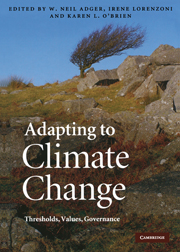Book contents
- Frontmatter
- Contents
- List of contributors
- Preface
- 1 Adaptation now
- Part I Adapting to thresholds in physical and ecological systems
- Part II The role of values and culture in adaptation
- Part III Governance, knowledge and technologies for adaptation
- 20 Whether our levers are long enough and the fulcrum strong? Exploring the soft underbelly of adaptation decisions and actions
- 21 Decentralized planning and climate adaptation: toward transparent governance
- 22 Climate adaptation, local institutions and rural livelihoods
- 23 Adaptive governance for a changing coastline: science, policy and publics in search of a sustainable future
- 24 Climate change, international cooperation and adaptation in transboundary water management
- 25 Decentralization: a window of opportunity for successful adaptation to climate change?
- 26 Adapting to climate change in Sámi reindeer herding: the nation-state as problem and solution
- 27 Limits to adaptation: analysing institutional constraints
- 28 Accessing diversification, networks and traditional resource management as adaptations to climate extremes
- 29 Governance limits to effective global financial support for adaptation
- 30 Organizational learning and governance in adaptation in urban development
- 31 Conclusions: Transforming the world
- Index
- References
21 - Decentralized planning and climate adaptation: toward transparent governance
Published online by Cambridge University Press: 31 August 2009
- Frontmatter
- Contents
- List of contributors
- Preface
- 1 Adaptation now
- Part I Adapting to thresholds in physical and ecological systems
- Part II The role of values and culture in adaptation
- Part III Governance, knowledge and technologies for adaptation
- 20 Whether our levers are long enough and the fulcrum strong? Exploring the soft underbelly of adaptation decisions and actions
- 21 Decentralized planning and climate adaptation: toward transparent governance
- 22 Climate adaptation, local institutions and rural livelihoods
- 23 Adaptive governance for a changing coastline: science, policy and publics in search of a sustainable future
- 24 Climate change, international cooperation and adaptation in transboundary water management
- 25 Decentralization: a window of opportunity for successful adaptation to climate change?
- 26 Adapting to climate change in Sámi reindeer herding: the nation-state as problem and solution
- 27 Limits to adaptation: analysing institutional constraints
- 28 Accessing diversification, networks and traditional resource management as adaptations to climate extremes
- 29 Governance limits to effective global financial support for adaptation
- 30 Organizational learning and governance in adaptation in urban development
- 31 Conclusions: Transforming the world
- Index
- References
Summary
Introduction: governance and adaptation to climate change
The emergent and growing literature on climate change and adaptation seems to have laid aside the effort to define a standardized, universally accepted set of concepts and theoretical frameworks and now acknowledges the coexistence of context-specific vulnerability and adaptation models (Eakin and Luers, 2006; Füssel and Klein, 2006). In effect, the hazard-based, economic-based and climate-based approaches resemble variations in linguistic dialect – similar enough to be mutually intelligible but different enough to create highly nuanced ‘theory communities’. The reality is, however, that hazards (and risk), poverty and global climate change are intimately intermingled in both theory and practice (Halsnaes and Verhagen, 2007; Vogel et al., 2007) – and so must be the models that explain the related dimensions of vulnerability and adaptation. This chapter seeks to contribute to both the scholarly understanding and the praxis of vulnerability and adaptation in specific socio-economic, physical and political contexts by demonstrating how systems of governance act to integrate these variant dimensions of adaptation. The specific context of a drought-affected state in north-east Brazil provides the empirical basis for our argument.
There are four underlying themes present in the variant models of vulnerability and adaptation that seem critical to how the praxis of adaptation unfolds in the face of climate variability and change. The first of these is that the process of adaptation necessarily entails the articulation of different levels of scale.
- Type
- Chapter
- Information
- Adapting to Climate ChangeThresholds, Values, Governance, pp. 335 - 349Publisher: Cambridge University PressPrint publication year: 2009
References
- 7
- Cited by



